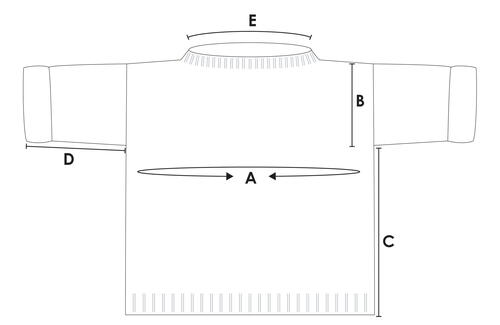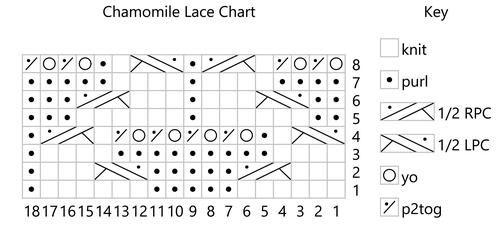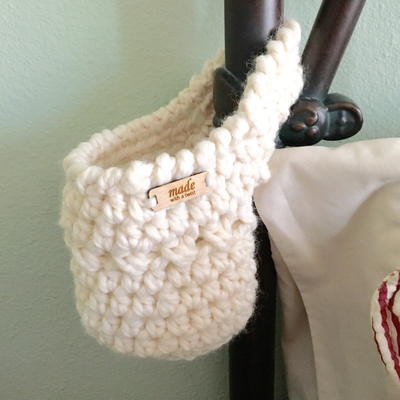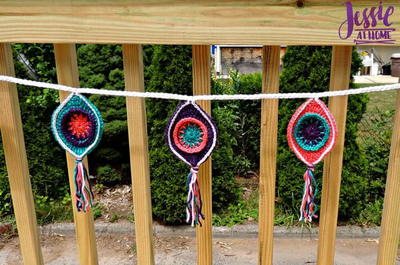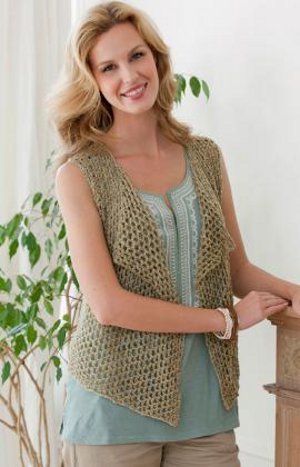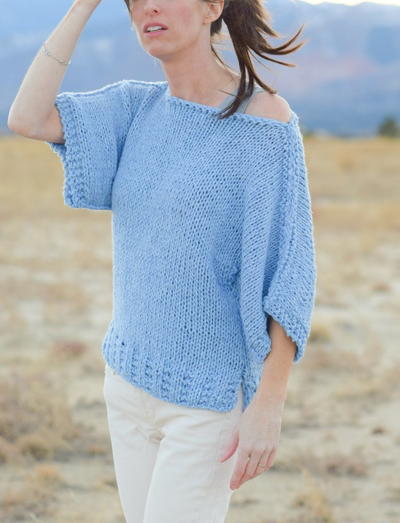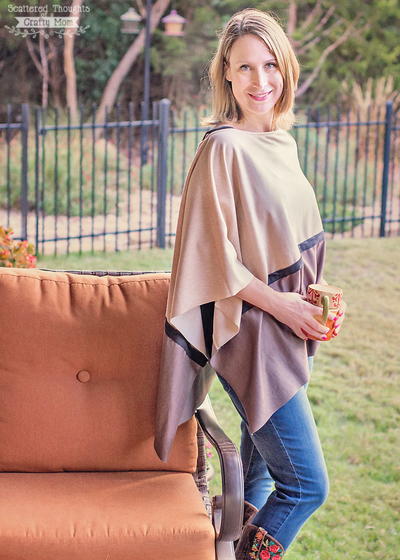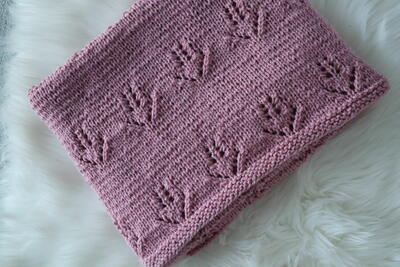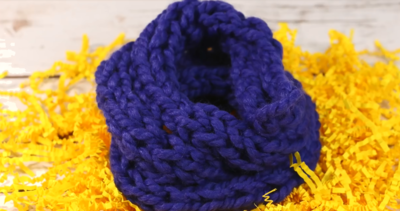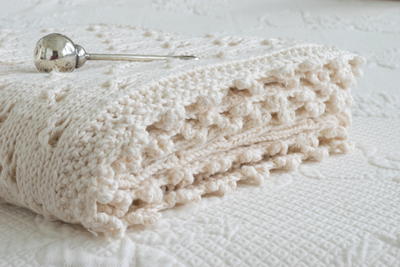Chamomile Shimmer Tee

There’s nothing quite so cheerful as a spray of chamomile blooms; they’re like tiny bursts of sunshine. I envisioned this design with an easy yet elevated look—like chamomile tea in a fancy teacup. The silk blend yarn and intricate texture dress up an otherwise simple concept that's perfect with jeans or over a sundress. This design is meant to be ever-so-slightly cropped for a flattering silhouette that hits just above the hip, but you can easily add length if you prefer a longer style. This is one of my personal favorites in this collection—and in my favorite color, too!
Skill Level: Intermediate
Construction
This highly textured, boxy-fit top is knit from the bottom up and worked in the round to the underarms. The front and back upper bodice sections are worked flat and smooth with shaped shoulders and a small, ribbed neckline. The drop-shoulder style is specifically constructed to fit with more ease than you might normally choose in a sweater—it’s part of the design. Be cautious about sizing down; your sleeves and neckline may not fit properly if you do.
Sizes
S (M, L, XL, 2X, 3X, 4X, 5X, 6X)
Fit Advice
Designed to be worn with approximately 8–10 in(20–25 cm) positive ease.
Finished Measurements
A) Bust Circumference: 40 (45.25, 50.75, 53.25, 58.75, 61.25, 66.75, 72, 74.75) in / 100 (113.25, 126.75, 133.25, 146.75, 153.25, 166.75, 180, 186.75) cm – blocked
B) Drop Shoulder Depth: 6 (6.5, 7, 7.5, 7.5, 8, 8.5, 8.5, 9) in / 15.25 (16.5, 17.75, 19, 19, 20.25, 21.5, 21.5, 22.75) cm – prior to blocking
C) Underarm to Hem: 13 (13, 13, 14, 14, 15, 15, 15, 15) in / 33 (33, 33, 35.5, 35.5, 38, 38, 38, 38) cm – prior to blocking; expect 1.5–2 in (3.75–5 cm) growth with blocking
D) Sleeve Length: 7 in (17.75 cm) – unblocked
E) Back Neckline Width: 11.25 in (28.75 cm)– blocked
Abbreviations:
[ ] - brackets indicate a repeat
1/2RPC - 1/2 right purl cross cable—slip 2 sts to cable needle and hold to back of work, k1 st, then p2 from cable needle
1/2LPC - 1/2 left purl cross cable—slip 1 st to cable needle and hold to front of work, purl next 2 sts, then knit the st from the cable needle
Bet - between
BO - bind off
BOR - beginning of row/round
CO - cast on
Dec - decrease/decreases/decreased
Inc - increase/increases/increased
K - knit
K2tog - knit two stitches together (dec 1)
M1L - make one stitch, left leaning (inc 1)
P - purl
P2tog - purl 2 sts together (dec 1)
PM - place marker
Rep - repeat
rnd/s - round/rounds
RS - right side
Ssk - slip one st knitwise, slip the next st knitwise, then return the two sts back to the left needle and knit the two together through the back loop (dec 1)
st/s - stitch/stitches
WS - wrong side
Yo - yarn over (inc 1)
X - denotes sizes not represented in this line of instruction
Materials List
-
Yarn
Sport Weight | Malabrigo Susurro | 50% Silk, 25% Merino, 25% Linen | 325 yards (297 meters) in 3.5 oz (100 grams) | 1029 (1111, 1199, 1295, 1399, 1511, 1632, 1763, 1904) yards / 941 (1016, 1096, 1184, 1279, 1381, 1492, 1612, 1740) meters
-
Color: Frank Ochre
Note: Variations in yarn choice orrow/round gauge may impact yarn consumption. If in doubt, roundup to the nearest skein.
-
Needles
Body:
US 4 (3.5 mm)* 24–40-in (60–100-cm) circular needle
Neckline:
US 3 (3.25 mm) 16-in (40-cm) circular needle
Sleeves:
US 4 (3.5 mm) 12-in (30-cm) circular needle or DPNs
*Or size needed to achieve gauge. Adjust other needle sizes accordingly.
-
Notions
- Stitch markers (including locking markers)
- Waste yarn or spare needles, for holding stitches
- Blocking pins and mats
- Cable needle
- Darning needle to weave ends and seam shoulders
INSTRUCTIONS:
Gauge
27 sts and 36 rows/rounds in4 in (10 cm) in lace pattern with largest needle, blocked
24 sts and 30 rows/rounds in 4 in (10 cm) in stockinette stitch with largest needle, blocked—for both of these measurements, row gauge is less critical but may affect yarn consumption
Chamomile Shimmer Tee Pattern
With US Size 4 (3.5 mm) 24–40-in (60–100-cm) circular needle—or size needed to obtain gauge— CO 272 (308, 344, 360, 396, 416, 452, 488, 504) sts using cable cast-on method. Do not join in the rnd yet. (Note: The cable cast-on begins your work immediately on the RS.)
-
Set-Up Row (RS): [K2, p2] rep bet brackets to end, then PM and join to work in the rnd, being careful not to twist your sts.
-
Ribbing Rnd: [K2, p2] rep bet brackets to end. Rep this rnd until work measures approximately 2 in (5 cm).
-
Sizes S, M, L, 3X, 4X and 5X ONLY – Next Rnd: K one rnd, decreasing 2 (2, 2, x, x, 2, 2, 2, x) sts using k2tog—270 (306, 342, x, x, 414, 450, 486, x) sts.
-
Sizes XL, 2X, and 6X ONLY – Next Rnd: K to end.
-
Next Rnd: Work Chamomile Lace pattern (beginning with Rnd 1 of chart or written instructions, worked over 18 sts per repeat) to end.
Continue working the lower body in the rnd as established, repeating the lace chart rnds in order, until your work measures 13 (13, 13, 14, 14, 15, 15, 15, 15) in / 33 (33, 33, 35.5, 35.5, 38, 38, 38, 38) cm from cast-on edge, ending after an odd- numbered row. Remove BOR on the next row.
Upper Bodice
Going forward, you will separate the front and back bodice sections and work back and forth on each section, flat, beginning with the front. You will return to work the back afterward.
Tip: As you begin working flat, be sure to keep your edges tidy. To do this, work the first st tighter than usual, then insert the tip of your needle into the second st, and pull the working yarn tight again to draw the first st a little tighter. Then proceed with the remainder of the row with normal tension. Do this at the start of every row (RS and WS) for nicer edges that will be easier to finish later.
-
Sizes S, M, L, 3X, 4X, and 5X ONLY – Next Rnd: K4, PM, K135 (153, 171, x, x, 207, 225, 243, x) sts, then stop. Slide remaining 135 (153, 171, x, x, 207, 225, 243, x) sts onto a long separate needle or waste yarn, including the first 4 sts you worked on this round. (This will shift the pattern place- ment so that it’s relatively centered.)
-
Sizes XL, 2X, and 6X ONLY – Next Rnd: Kx (x, x, 180, 198, x, x, x, 252) sts, then stop. Slide remaining x (x, x, 180, 198, x, x, x, 252) sts onto a long separate needle or waste yarn.
-
Stitch Count Check-In
135 (153, 171, 180, 198, 207, 225, 243, 252) -
Front
Next Row (WS): P2, k1, p to last 3 sts, k1, p2.
Next Row (RS): K2, p1, k to last 3 sts, p1, k2.
Rep these two rows until your flat section measures 6 (6.5, 7, 7.5, 7.5, 8, 8.5, 8.5, 9) in / 15.25 (16.5, 17.75, 19, 19, 20.25, 21.5, 21.5, 22.75) cm from where you began working flat, ending after a WS row (ready to work a RS).
Front Shoulder and Neckline Shaping
-
Next Row (RS): BO 7 (9, 10, 11, 13, 14, 15, 17, 18) sts knitwise, then k31 (38, 44, 48, 53, 57, 64, 71, 74) sts—this is the left front shoulder. BO next 59 (59, 63, 62, 66, 65, 67, 67, 68) sts knitwise for center front neckline. K38 (47, 54, 59, 66, 71, 79, 88, 92) sts to end—this is the right front shoulder.
Place the 31 (38, 44, 48, 53, 57, 64, 71, 74) sts of left front shoulder onto a holder or waste yarn; you will return to work them later. You will now work only on the right front shoulder and neckline dec as you proceed in this section. -
Right Front Shoulder
Next Row (WS): BO 7 (9, 10, 11, 13, 14, 15, 17, 18) sts purlwise, p to end.
Next Row (RS): K1, ssk, k to end—1 st dec.
Next Row (WS): BO 7 (9, 10, 11, 13, 14, 15, 17, 18) sts purlwise, p to end.
Rep these two rows twice more (for a total of 3).
Next Row (RS): K1, ssk, BO remaining sts knit- wise (including the first two). -
Left Front Shoulder
Return to the left shoulder sts and place them back on your working needles. Position your yarn to begin a WS row.
Next Row (WS): P1, p2tog, p to end—1 st dec. Next Row (RS): BO 7 (9, 10, 11, 13, 14, 15, 17, 18) sts knitwise, k to end.
Next Row (WS): P1, p2tog, p to end—1 st dec. Rep these two rows twice more (for a total of 3).
Next Row (RS): BO remaining sts knitwise. -
Back
Return back sts to needles and join working yarn, ready to work a RS row—135 (153, 171, 180, 198, 207, 225, 243, 252) sts on needle.
Next Row (RS): K2, p1, k to last 3 sts, p1, k2.
Next Row (WS): P2, k1, p to last 3 sts, k1, p2.
Rep these two rows until your flat section measures 6 (6.5, 7, 7.5, 7.5, 8, 8.5, 8.5, 9) in / 15.25 (16.5, 17.75, 19, 19, 20.25, 21.5, 22.75) cm and is the same length as the front (before you worked the first BO row). End after a WS row (ready to work a RS). -
Back Shoulder Shaping
Next Row (RS): BO 7 (9, 10, 11, 13, 14, 15, 17, 18) sts knitwise, k to end.
Next Row (WS): BO 7 (9, 10, 11, 13, 14, 15, 17, 18) sts purlwise, p to end.
Rep these two rows 3 times more (for a total of 4).
Next Row (RS): BO remaining 79 (81, 91, 92, 94, 95, 105, 107, 108) sts knitwise for center back neckline. -
Shoulder Finishing
Seam the shoulder sts together on each side to the neckline, ensuring that the front, back, and shoulder bind-off sections line up perfectly. See seaming and grafting tutorials on my website here: oliveknits.com/grafting.
Neckline
With US Size 3 (3.25 mm) 16 in (40 cm) circular needle—or one size smaller than needed to achieve gauge—pick up and k almost every available st around the neckline, ending with a multiple of 4. PM and join to work in the rnd.
-
Ribbing
Next Rnd: [K2, p2] rep bet brackets to end. Repeat this rnd until ribbed edge measures approximately 1.25 in (3.25 cm) wide. BO in pat- tern with medium tension.
Tip: You can adjust the size and feel of your neckline by doing one of the follow- ing: For a looser neckline, make sure you’ve picked up every available st and that your bind off is not too tight. If your neckline is too open (or your ribbing flares out), try picking up slightly fewer sts—such as 5 of every 6 available sts—and/or binding off a little more tightly. Necklines like this one are very easy to adjust with just a few simple changes to your technique.
Sleeves
Beginning with either armhole, and with US Size 4 (3.5 mm) 12 in (40 cm) circular needle or DPNs— or size needed to achieve gauge—pick up approximately 4 of every 5 sts around the first armhole opening, starting at the underarm. Jot down the number of sts you’ve picked up so you can match the same number on the other sleeve. Starting at the center of the underarm, PM, join working yarn and join to work in the rnd.
-
Next 13 Rnds: K to end of rnd.
-
Dec Rnd: K2, ssk, k to last 4 sts, k2tog, k2—2 sts dec.
Continue working sleeve in the rnd, decreasing every fifth rnd until sleeve measures approximately 10 in (25.5 cm) from pickup.
BO knitwise with medium tension (not too tight, not too loose). If the cuff edge is restrictive, BO again more loosely.
Rep for second sleeve. -
Finishing
Weave in ends on the WS and wet block for best results. Soak in lukewarm water with a splash of fiber wash for 20 minutes to gently cleanse and relax the fiber. Press out excess water and lay flat, pinning into shape. Pin the sleeves flat for the first 24 hours, then fold each cuff up 1.5 in (3.75 cm) and fold them a second time (the same width). Press the folded cuffs flat and pin them so they will continue to dry folded. Turn as needed for even drying.
When dry, use matching yarn from your project to gently “tack” the cuff folds in two places each— once at the center of the underarm, and once at the center of the top of the arm. Be sure to stitch through all the layers. These sts should be relatively invisible and are necessary to keep the folded cuff in place. (Use a few more sts to secure your cuff, if needed.)
Chart Written Directions
Here is a link to the chart.
Rnd 1: [K6, p5, k6, p1] rep bet brackets to end.
Rnd 2: [K3, 1/2RPC, p5, 1/2LPC, k3, p1] rep bet brackets to end.
Rnd 3: [K4, p9, k4, p1] rep bet brackets to end.
Rnd 4: [1/2LPC, k1, p1, (yo, p2tog) 4 times, k1, 1/2RPC, p1] rep bet brackets to end.
Rnd 5: [P2, k6, p1, k6, p3] to end.
Rnd 6: [P2, 1/2LPC, k3, p1, k3, 1/2RPC, p3] rep bet brackets to end.
Rnd 7: [P4, k4, p1, k4, p5] rep bet brackets to end.
Rnd 8: [(YO, p2tog) twice, k1, 1/2RPC, p1, 1/2LPC, k1, p1, (yo, p2tog) twice] rep bet brackets to end.
Credit:
Reprinted with permission from Knitting Light by Marie Greene. Page Street Publishing Co. 2024. Photo credit: Annie Loaiza.
Read NextSarah J Blanket

